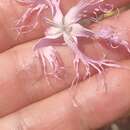en
names in breadcrumbs


Dianthus broteri is a species of flowering plant in the carnation family Caryophyllaceae. It is native to Portugal and Spain, preferring to grow close to the coasts.[2] Dianthus broteri is a complex of polyploid races, with 2n=2x=30, 2n=4x=60, 2n=6x=90 and 2n=12x=180 chromosomes detected in different populations, the largest polyploid series in the genus.[3][4]
Dianthus broteri is a species of flowering plant in the carnation family Caryophyllaceae. It is native to Portugal and Spain, preferring to grow close to the coasts. Dianthus broteri is a complex of polyploid races, with 2n=2x=30, 2n=4x=60, 2n=6x=90 and 2n=12x=180 chromosomes detected in different populations, the largest polyploid series in the genus.